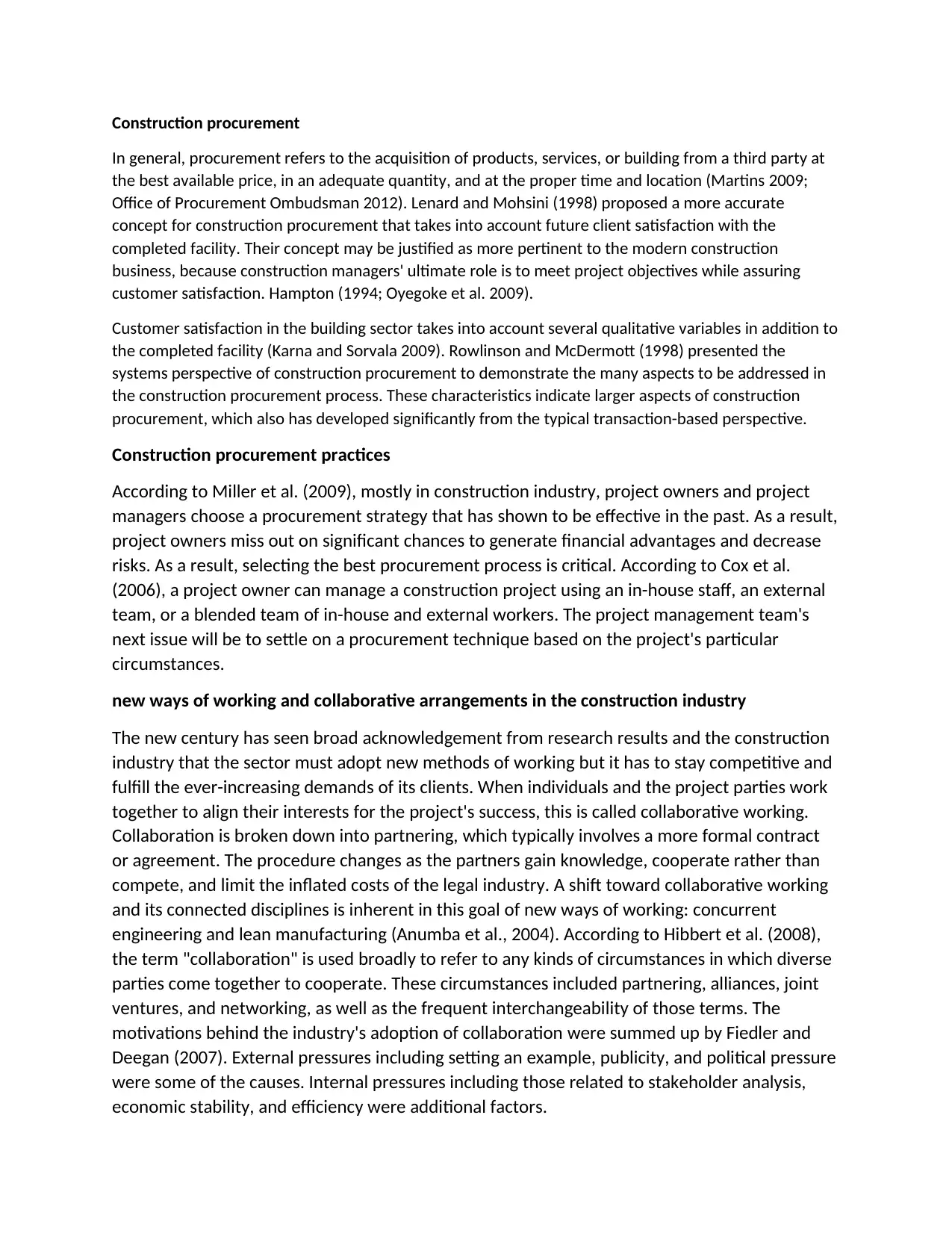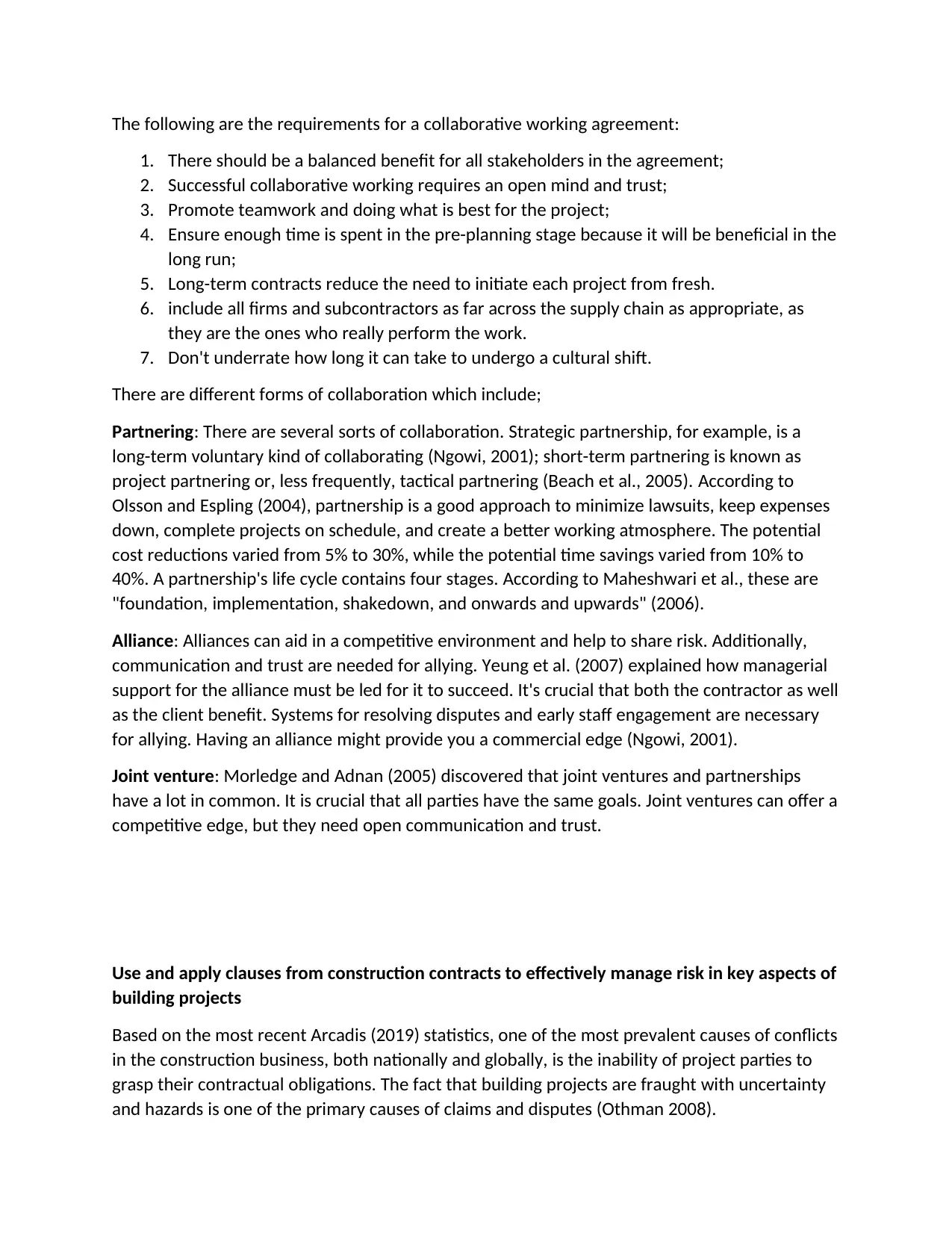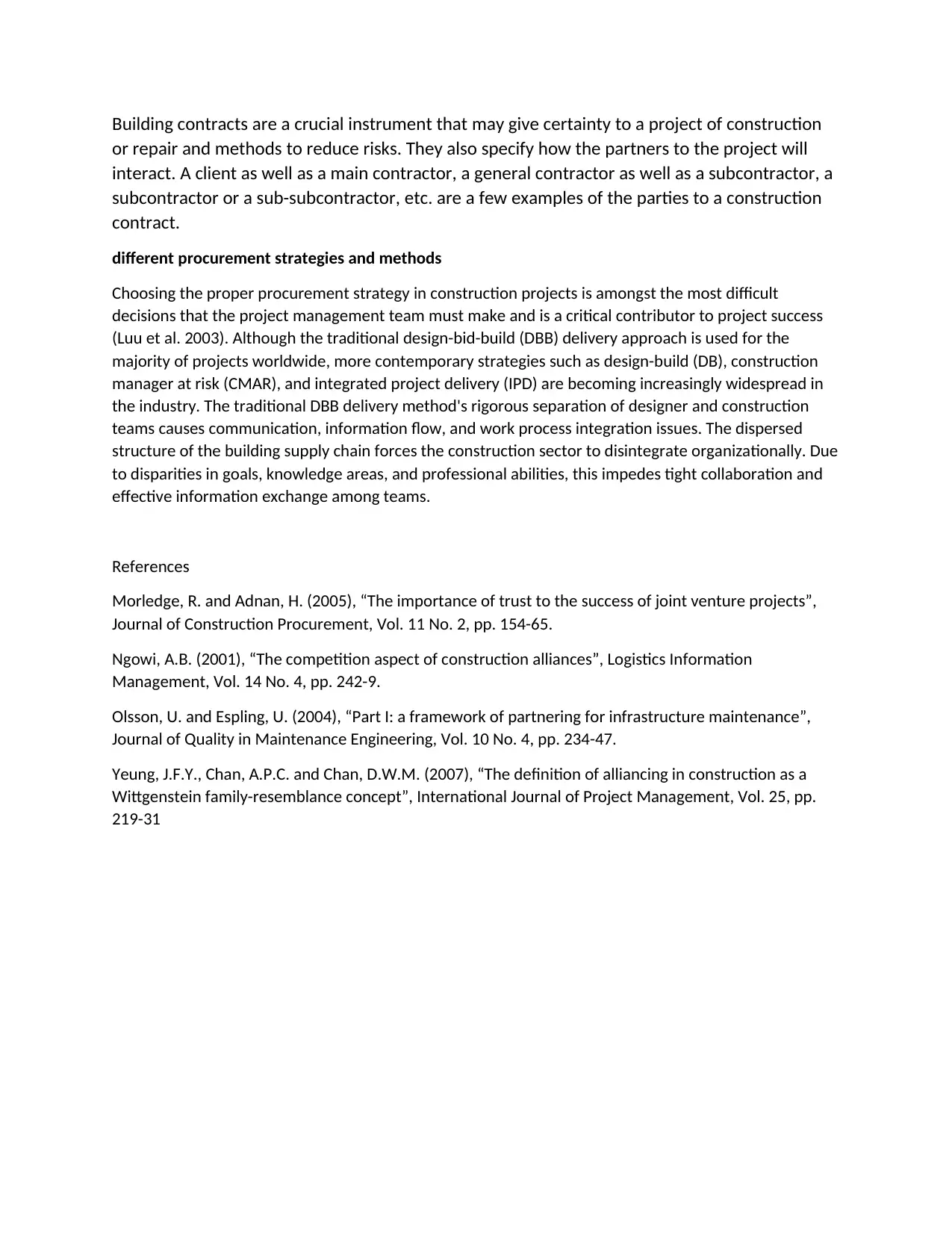Construction Procurement Methods: Collaboration and Contract Use
VerifiedAdded on 2023/02/07
|3
|1456
|330
Essay
AI Summary
This essay provides a comprehensive overview of construction procurement practices, highlighting the shift towards collaborative working arrangements in the construction industry. It explores various collaborative methods such as partnering, alliances, and joint ventures, emphasizing the importance of trust, communication, and shared goals for project success. The essay also discusses the critical role of construction contracts in managing risk and ensuring clarity of obligations among project parties. Furthermore, it examines different procurement strategies, including traditional design-bid-build (DBB) and more contemporary approaches like design-build (DB), construction manager at risk (CMAR), and integrated project delivery (IPD), while referencing relevant research and statistics to support its analysis. Desklib offers a platform to access this and many other solved assignments.

Construction procurement
In general, procurement refers to the acquisition of products, services, or building from a third party at
the best available price, in an adequate quantity, and at the proper time and location (Martins 2009;
Office of Procurement Ombudsman 2012). Lenard and Mohsini (1998) proposed a more accurate
concept for construction procurement that takes into account future client satisfaction with the
completed facility. Their concept may be justified as more pertinent to the modern construction
business, because construction managers' ultimate role is to meet project objectives while assuring
customer satisfaction. Hampton (1994; Oyegoke et al. 2009).
Customer satisfaction in the building sector takes into account several qualitative variables in addition to
the completed facility (Karna and Sorvala 2009). Rowlinson and McDermott (1998) presented the
systems perspective of construction procurement to demonstrate the many aspects to be addressed in
the construction procurement process. These characteristics indicate larger aspects of construction
procurement, which also has developed significantly from the typical transaction-based perspective.
Construction procurement practices
According to Miller et al. (2009), mostly in construction industry, project owners and project
managers choose a procurement strategy that has shown to be effective in the past. As a result,
project owners miss out on significant chances to generate financial advantages and decrease
risks. As a result, selecting the best procurement process is critical. According to Cox et al.
(2006), a project owner can manage a construction project using an in-house staff, an external
team, or a blended team of in-house and external workers. The project management team's
next issue will be to settle on a procurement technique based on the project's particular
circumstances.
new ways of working and collaborative arrangements in the construction industry
The new century has seen broad acknowledgement from research results and the construction
industry that the sector must adopt new methods of working but it has to stay competitive and
fulfill the ever-increasing demands of its clients. When individuals and the project parties work
together to align their interests for the project's success, this is called collaborative working.
Collaboration is broken down into partnering, which typically involves a more formal contract
or agreement. The procedure changes as the partners gain knowledge, cooperate rather than
compete, and limit the inflated costs of the legal industry. A shift toward collaborative working
and its connected disciplines is inherent in this goal of new ways of working: concurrent
engineering and lean manufacturing (Anumba et al., 2004). According to Hibbert et al. (2008),
the term "collaboration" is used broadly to refer to any kinds of circumstances in which diverse
parties come together to cooperate. These circumstances included partnering, alliances, joint
ventures, and networking, as well as the frequent interchangeability of those terms. The
motivations behind the industry's adoption of collaboration were summed up by Fiedler and
Deegan (2007). External pressures including setting an example, publicity, and political pressure
were some of the causes. Internal pressures including those related to stakeholder analysis,
economic stability, and efficiency were additional factors.
In general, procurement refers to the acquisition of products, services, or building from a third party at
the best available price, in an adequate quantity, and at the proper time and location (Martins 2009;
Office of Procurement Ombudsman 2012). Lenard and Mohsini (1998) proposed a more accurate
concept for construction procurement that takes into account future client satisfaction with the
completed facility. Their concept may be justified as more pertinent to the modern construction
business, because construction managers' ultimate role is to meet project objectives while assuring
customer satisfaction. Hampton (1994; Oyegoke et al. 2009).
Customer satisfaction in the building sector takes into account several qualitative variables in addition to
the completed facility (Karna and Sorvala 2009). Rowlinson and McDermott (1998) presented the
systems perspective of construction procurement to demonstrate the many aspects to be addressed in
the construction procurement process. These characteristics indicate larger aspects of construction
procurement, which also has developed significantly from the typical transaction-based perspective.
Construction procurement practices
According to Miller et al. (2009), mostly in construction industry, project owners and project
managers choose a procurement strategy that has shown to be effective in the past. As a result,
project owners miss out on significant chances to generate financial advantages and decrease
risks. As a result, selecting the best procurement process is critical. According to Cox et al.
(2006), a project owner can manage a construction project using an in-house staff, an external
team, or a blended team of in-house and external workers. The project management team's
next issue will be to settle on a procurement technique based on the project's particular
circumstances.
new ways of working and collaborative arrangements in the construction industry
The new century has seen broad acknowledgement from research results and the construction
industry that the sector must adopt new methods of working but it has to stay competitive and
fulfill the ever-increasing demands of its clients. When individuals and the project parties work
together to align their interests for the project's success, this is called collaborative working.
Collaboration is broken down into partnering, which typically involves a more formal contract
or agreement. The procedure changes as the partners gain knowledge, cooperate rather than
compete, and limit the inflated costs of the legal industry. A shift toward collaborative working
and its connected disciplines is inherent in this goal of new ways of working: concurrent
engineering and lean manufacturing (Anumba et al., 2004). According to Hibbert et al. (2008),
the term "collaboration" is used broadly to refer to any kinds of circumstances in which diverse
parties come together to cooperate. These circumstances included partnering, alliances, joint
ventures, and networking, as well as the frequent interchangeability of those terms. The
motivations behind the industry's adoption of collaboration were summed up by Fiedler and
Deegan (2007). External pressures including setting an example, publicity, and political pressure
were some of the causes. Internal pressures including those related to stakeholder analysis,
economic stability, and efficiency were additional factors.
Paraphrase This Document
Need a fresh take? Get an instant paraphrase of this document with our AI Paraphraser

The following are the requirements for a collaborative working agreement:
1. There should be a balanced benefit for all stakeholders in the agreement;
2. Successful collaborative working requires an open mind and trust;
3. Promote teamwork and doing what is best for the project;
4. Ensure enough time is spent in the pre-planning stage because it will be beneficial in the
long run;
5. Long-term contracts reduce the need to initiate each project from fresh.
6. include all firms and subcontractors as far across the supply chain as appropriate, as
they are the ones who really perform the work.
7. Don't underrate how long it can take to undergo a cultural shift.
There are different forms of collaboration which include;
Partnering: There are several sorts of collaboration. Strategic partnership, for example, is a
long-term voluntary kind of collaborating (Ngowi, 2001); short-term partnering is known as
project partnering or, less frequently, tactical partnering (Beach et al., 2005). According to
Olsson and Espling (2004), partnership is a good approach to minimize lawsuits, keep expenses
down, complete projects on schedule, and create a better working atmosphere. The potential
cost reductions varied from 5% to 30%, while the potential time savings varied from 10% to
40%. A partnership's life cycle contains four stages. According to Maheshwari et al., these are
"foundation, implementation, shakedown, and onwards and upwards" (2006).
Alliance: Alliances can aid in a competitive environment and help to share risk. Additionally,
communication and trust are needed for allying. Yeung et al. (2007) explained how managerial
support for the alliance must be led for it to succeed. It's crucial that both the contractor as well
as the client benefit. Systems for resolving disputes and early staff engagement are necessary
for allying. Having an alliance might provide you a commercial edge (Ngowi, 2001).
Joint venture: Morledge and Adnan (2005) discovered that joint ventures and partnerships
have a lot in common. It is crucial that all parties have the same goals. Joint ventures can offer a
competitive edge, but they need open communication and trust.
Use and apply clauses from construction contracts to effectively manage risk in key aspects of
building projects
Based on the most recent Arcadis (2019) statistics, one of the most prevalent causes of conflicts
in the construction business, both nationally and globally, is the inability of project parties to
grasp their contractual obligations. The fact that building projects are fraught with uncertainty
and hazards is one of the primary causes of claims and disputes (Othman 2008).
1. There should be a balanced benefit for all stakeholders in the agreement;
2. Successful collaborative working requires an open mind and trust;
3. Promote teamwork and doing what is best for the project;
4. Ensure enough time is spent in the pre-planning stage because it will be beneficial in the
long run;
5. Long-term contracts reduce the need to initiate each project from fresh.
6. include all firms and subcontractors as far across the supply chain as appropriate, as
they are the ones who really perform the work.
7. Don't underrate how long it can take to undergo a cultural shift.
There are different forms of collaboration which include;
Partnering: There are several sorts of collaboration. Strategic partnership, for example, is a
long-term voluntary kind of collaborating (Ngowi, 2001); short-term partnering is known as
project partnering or, less frequently, tactical partnering (Beach et al., 2005). According to
Olsson and Espling (2004), partnership is a good approach to minimize lawsuits, keep expenses
down, complete projects on schedule, and create a better working atmosphere. The potential
cost reductions varied from 5% to 30%, while the potential time savings varied from 10% to
40%. A partnership's life cycle contains four stages. According to Maheshwari et al., these are
"foundation, implementation, shakedown, and onwards and upwards" (2006).
Alliance: Alliances can aid in a competitive environment and help to share risk. Additionally,
communication and trust are needed for allying. Yeung et al. (2007) explained how managerial
support for the alliance must be led for it to succeed. It's crucial that both the contractor as well
as the client benefit. Systems for resolving disputes and early staff engagement are necessary
for allying. Having an alliance might provide you a commercial edge (Ngowi, 2001).
Joint venture: Morledge and Adnan (2005) discovered that joint ventures and partnerships
have a lot in common. It is crucial that all parties have the same goals. Joint ventures can offer a
competitive edge, but they need open communication and trust.
Use and apply clauses from construction contracts to effectively manage risk in key aspects of
building projects
Based on the most recent Arcadis (2019) statistics, one of the most prevalent causes of conflicts
in the construction business, both nationally and globally, is the inability of project parties to
grasp their contractual obligations. The fact that building projects are fraught with uncertainty
and hazards is one of the primary causes of claims and disputes (Othman 2008).

Building contracts are a crucial instrument that may give certainty to a project of construction
or repair and methods to reduce risks. They also specify how the partners to the project will
interact. A client as well as a main contractor, a general contractor as well as a subcontractor, a
subcontractor or a sub-subcontractor, etc. are a few examples of the parties to a construction
contract.
different procurement strategies and methods
Choosing the proper procurement strategy in construction projects is amongst the most difficult
decisions that the project management team must make and is a critical contributor to project success
(Luu et al. 2003). Although the traditional design-bid-build (DBB) delivery approach is used for the
majority of projects worldwide, more contemporary strategies such as design-build (DB), construction
manager at risk (CMAR), and integrated project delivery (IPD) are becoming increasingly widespread in
the industry. The traditional DBB delivery method's rigorous separation of designer and construction
teams causes communication, information flow, and work process integration issues. The dispersed
structure of the building supply chain forces the construction sector to disintegrate organizationally. Due
to disparities in goals, knowledge areas, and professional abilities, this impedes tight collaboration and
effective information exchange among teams.
References
Morledge, R. and Adnan, H. (2005), “The importance of trust to the success of joint venture projects”,
Journal of Construction Procurement, Vol. 11 No. 2, pp. 154-65.
Ngowi, A.B. (2001), “The competition aspect of construction alliances”, Logistics Information
Management, Vol. 14 No. 4, pp. 242-9.
Olsson, U. and Espling, U. (2004), “Part I: a framework of partnering for infrastructure maintenance”,
Journal of Quality in Maintenance Engineering, Vol. 10 No. 4, pp. 234-47.
Yeung, J.F.Y., Chan, A.P.C. and Chan, D.W.M. (2007), “The definition of alliancing in construction as a
Wittgenstein family-resemblance concept”, International Journal of Project Management, Vol. 25, pp.
219-31
or repair and methods to reduce risks. They also specify how the partners to the project will
interact. A client as well as a main contractor, a general contractor as well as a subcontractor, a
subcontractor or a sub-subcontractor, etc. are a few examples of the parties to a construction
contract.
different procurement strategies and methods
Choosing the proper procurement strategy in construction projects is amongst the most difficult
decisions that the project management team must make and is a critical contributor to project success
(Luu et al. 2003). Although the traditional design-bid-build (DBB) delivery approach is used for the
majority of projects worldwide, more contemporary strategies such as design-build (DB), construction
manager at risk (CMAR), and integrated project delivery (IPD) are becoming increasingly widespread in
the industry. The traditional DBB delivery method's rigorous separation of designer and construction
teams causes communication, information flow, and work process integration issues. The dispersed
structure of the building supply chain forces the construction sector to disintegrate organizationally. Due
to disparities in goals, knowledge areas, and professional abilities, this impedes tight collaboration and
effective information exchange among teams.
References
Morledge, R. and Adnan, H. (2005), “The importance of trust to the success of joint venture projects”,
Journal of Construction Procurement, Vol. 11 No. 2, pp. 154-65.
Ngowi, A.B. (2001), “The competition aspect of construction alliances”, Logistics Information
Management, Vol. 14 No. 4, pp. 242-9.
Olsson, U. and Espling, U. (2004), “Part I: a framework of partnering for infrastructure maintenance”,
Journal of Quality in Maintenance Engineering, Vol. 10 No. 4, pp. 234-47.
Yeung, J.F.Y., Chan, A.P.C. and Chan, D.W.M. (2007), “The definition of alliancing in construction as a
Wittgenstein family-resemblance concept”, International Journal of Project Management, Vol. 25, pp.
219-31
⊘ This is a preview!⊘
Do you want full access?
Subscribe today to unlock all pages.

Trusted by 1+ million students worldwide
1 out of 3
Your All-in-One AI-Powered Toolkit for Academic Success.
+13062052269
info@desklib.com
Available 24*7 on WhatsApp / Email
![[object Object]](/_next/static/media/star-bottom.7253800d.svg)
Unlock your academic potential
Copyright © 2020–2025 A2Z Services. All Rights Reserved. Developed and managed by ZUCOL.
